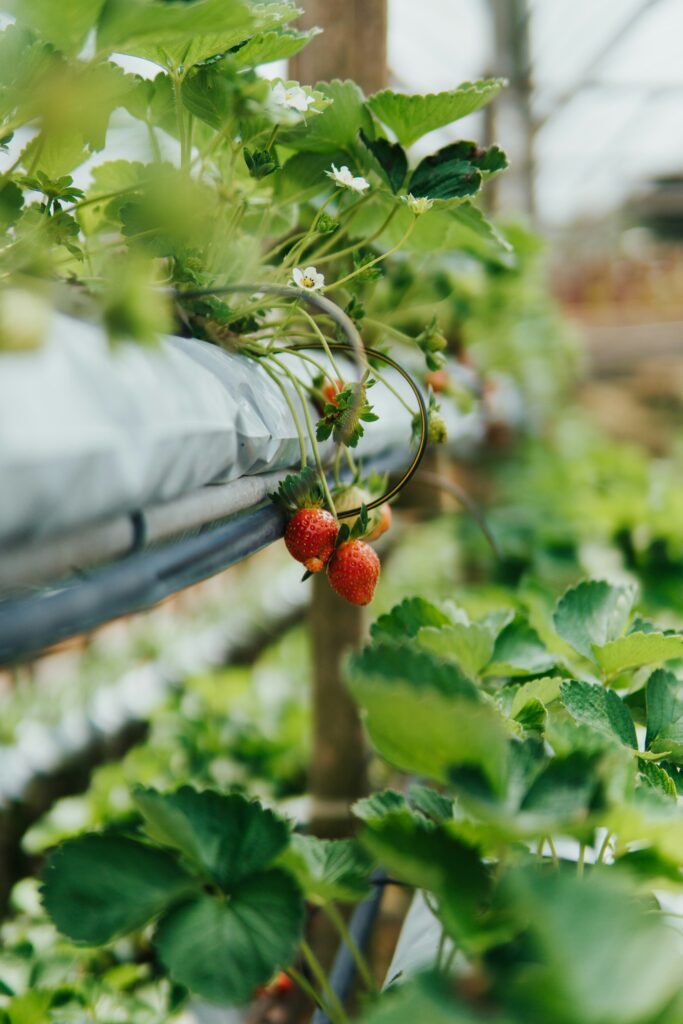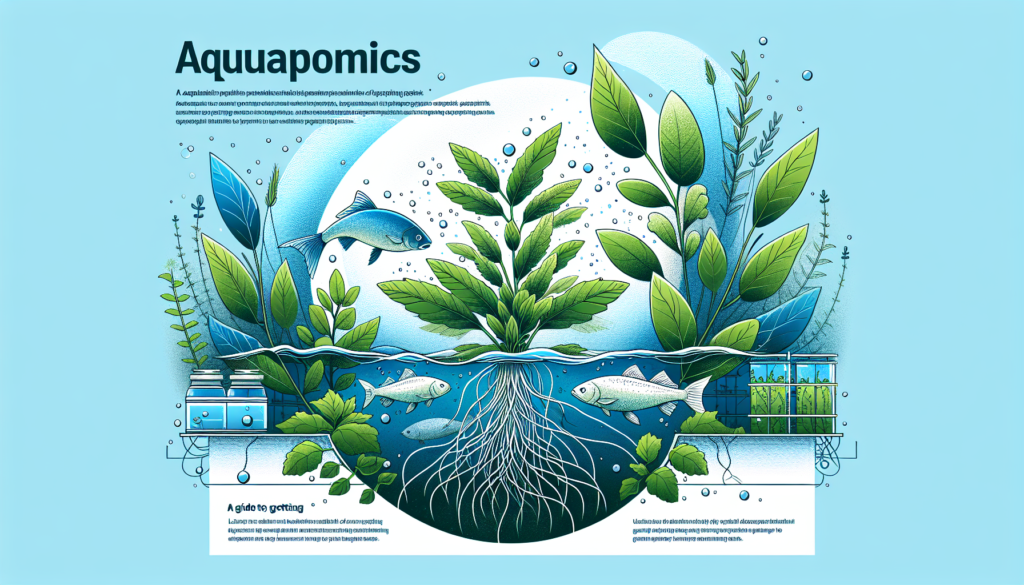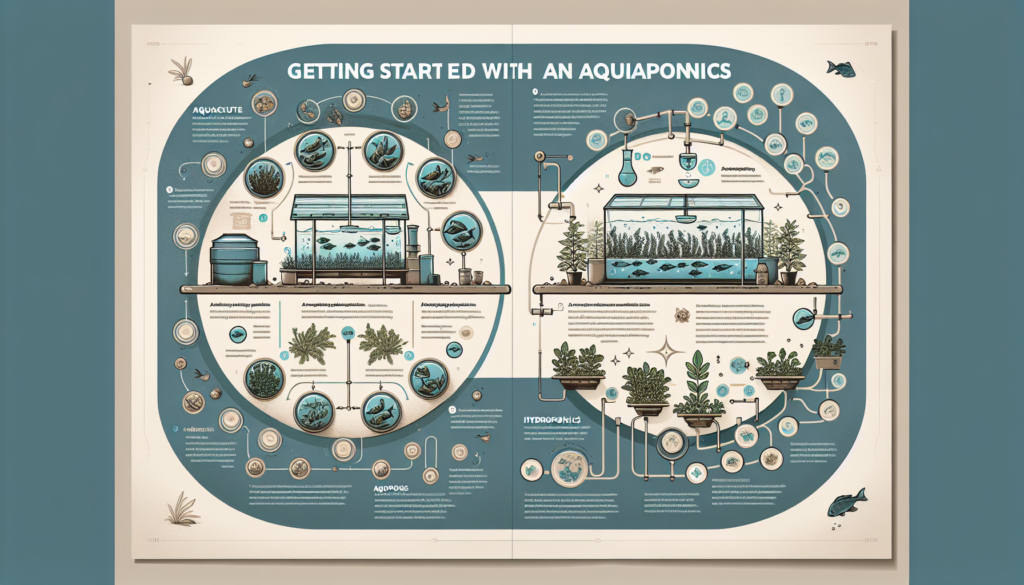Looking to dive into the world of aquaponics? Look no further! “Aquaponics: A Guide To Getting Started” is here to provide you with all the essential information you need to begin your journey into this fascinating and sustainable method of farming. From understanding the principles of aquaponics to designing and sizing your system, choosing the right fish, and selecting plants, this guide is your go-to resource for all things aquaponics. So, grab your gardening gloves and get ready to embark on an exciting adventure that combines the best of aquaculture and hydroponics.
Aquaponics: A Guide to Getting Started
Aquaponics is an innovative and sustainable method of growing plants and raising fish in a symbiotic environment. This unique agricultural system allows you to cultivate organic produce while also raising fish for consumption. In this comprehensive guide, we will walk you through the various aspects of aquaponics, from sizing and design to feeding and monitoring. So let’s dive in and explore the exciting world of aquaponics!
Sizing and Design
When starting an aquaponics system, one of the first things to consider is the space available. Whether you plan to set up your system indoors or outdoors, it’s essential to determine the area you have at your disposal. Indoor systems are more suitable for those with limited space, whereas outdoor systems can accommodate larger setups.
To ensure the success of your aquaponics system, it’s crucial to calculate the system capacity accurately. This involves considering factors such as the number of fish you want to raise and the number of plants you wish to grow. By determining the system capacity, you can design a system that meets your specific needs.
Scalability is another key aspect to consider when designing your aquaponics system. As your interest and expertise in aquaponics grow, you may want to expand your system. Planning for scalability from the start will save you time and effort in the future.

Principles of Aquaponics
To truly master aquaponics, it’s important to understand the underlying principles that make this agricultural system so effective. The nitrogen cycle is a fundamental process in aquaponics and plays a vital role in the health of your system. Nitrogen, in the form of ammonia, is excreted by fish and converted into nitrite and then nitrate by beneficial bacteria. This nitrate is then used as a nutrient by the plants, completing the cycle.
Speaking of beneficial bacteria, they are indispensable in an aquaponics system. These bacteria convert harmful substances, such as ammonia, into less toxic compounds, ensuring the well-being of your fish and plants. Establishing and maintaining a healthy colony of beneficial bacteria is crucial for the success of your system.
maintaining the right pH levels is another vital aspect of aquaponics. Fish and plants thrive in specific pH ranges, and it’s essential to monitor and adjust the pH to ensure optimal conditions for their growth. Likewise, optimizing temperature and light is crucial for the health and productivity of your plants and fish.
Balancing nutrient ratios is another factor to consider when it comes to the principles of aquaponics. Different plants have varying nutrient requirements, and it’s essential to provide them with the appropriate nutrients for healthy growth. Finding the right balance between fish waste and plant nutrient uptake is key to maintaining a thriving system.
Choosing the Right Fish
Choosing suitable fish for your aquaponics system is an exciting decision that depends on various factors. Some common fish species used in aquaponics include Tilapia, Trout, Catfish, and Koi. Each species has its own specific requirements and growth rate, so it’s essential to research and select fish that align with your goals and environmental conditions.
When selecting fish for your system, you must also consider their compatibility with each other. Some fish species may have aggressive tendencies, while others are more docile. Ensuring compatibility among the fish will help maintain a harmonious environment for them to thrive.
Feeding and maintaining fish health is an important responsibility in aquaponics. Choosing the right fish feed types that meet their nutritional needs is crucial for their growth and overall well-being. Monitoring their behavior, appetite, and general health regularly will allow you to detect any potential issues and address them promptly.

Planning Your Aquaponic System
Before diving headfirst into setting up your aquaponic system, taking the time to plan it thoroughly will save you headaches down the line. Deciding on the system type, such as media beds, nutrient film technique, or deep water culture, is the first step. Each system type has its own advantages and considerations, so it’s important to select one that suits your needs and preferences.
Determining the water volume required for your system is another vital aspect when planning. The water volume will depend on factors like the number of fish and the type of plants you intend to grow. Proper planning of the plumbing and pumping system will ensure efficient water circulation and nutrient distribution throughout the system.
Considering electricity and lighting is key to ensuring the success of your aquaponics system. Fish tanks and grow beds may require supplementary lighting, especially in indoor systems where natural light may be limited. Additionally, you need to ensure that you have access to an electrical supply suitable for powering pumps, fans, and other equipment.
Creating a maintenance schedule for your system is an essential part of planning. Regular tasks like monitoring water quality, checking pH levels, optimizing feeding, and maintaining equipment should be incorporated into a maintenance routine. By doing so, you can prevent potential issues and keep your system running smoothly.
Calculating the cost and budgeting for your aquaponics system is the final step in the planning process. This involves considering the expenses for fish, plants, equipment, utilities, and ongoing maintenance. Having a clear budget in mind will help you make informed decisions and ensure that your aquaponics venture is financially viable.
Selecting Plants for Aquaponics
The type of plants you choose to grow in your aquaponics system will depend on various factors such as your climate, available space, and personal preferences. Edible plants like lettuce, spinach, herbs, and tomatoes are popular choices in aquaponics due to their high demand and fast growth rates.
Considering the climate and season is crucial when selecting plants. Some plants thrive in colder climates, while others prefer warmer conditions. Understanding the specific requirements of different plants will help you create a suitable environment for their growth, ensuring a bountiful harvest.
Determining the planting methods is another step in selecting plants for aquaponics. You can choose from various methods such as floating raft systems, media beds, or vertical towers. Each planting method has its own advantages and considerations, so it’s essential to select the one most suitable for the plants you wish to grow.
Matching plant nutritional requirements to the fish waste produced in your system is crucial for maintaining a balanced ecosystem. Different plants have distinct nutrient needs, and it’s essential to ensure that they receive the necessary elements for healthy growth. Monitoring nutrient levels and adjusting accordingly will ensure optimal plant health and productivity.
Exploring crop rotation principles is a valuable practice in aquaponics. Rotating crops helps prevent the buildup of pests and diseases, improves soil health, and maximizes the utilization of nutrients. By planning your planting schedule and rotating crops strategically, you can create a more sustainable and productive aquaponics system.

Components of an Aquaponic System
Understanding the various components of an aquaponic system is key to its successful setup and operation. Here are the essential components you need to know:
Fish Tanks
Fish tanks are where your aquatic friends will reside. They should be appropriately sized and constructed to accommodate the number and size of fish you plan to raise. Adequate filtration and aeration systems are crucial for maintaining water quality and ensuring the comfort and health of the fish.
Grow Beds
Grow beds serve as the home for your plants, allowing their roots to absorb the nutrient-rich water. Choosing the right grow bed material, such as gravel or expanded clay pellets, is essential for supporting plant growth and maintaining a healthy root environment. Determining the appropriate bed depth and area is crucial for maximizing plant growth and utilizing space efficiently.
Filters and Filtration Systems
Filters play a vital role in ensuring water quality and removing solid waste from the system. Mechanical, biological, and chemical filtration systems work together to provide a clean and healthy environment for both fish and plants. Regular maintenance and cleaning of the filters are essential for their optimal performance.
Water Pumps and Circulation
Water pumps play a crucial role in circulating the water throughout the system, ensuring efficient nutrient distribution and oxygenation. Choosing a pump with the appropriate flow rate for your system size is essential for maintaining a balanced and thriving ecosystem. Proper water circulation helps prevent dead zones and promotes optimal plant and fish health.
Aeration Equipment
Maintaining adequate oxygen levels in the water is crucial for the well-being of your fish and plants. Aeration equipment, such as air stones or diffusers, helps enhance oxygen exchange, prevent stagnant zones, and promote healthy root growth. Proper aeration also assists in maintaining optimal conditions for beneficial bacteria to carry out their vital functions.
Monitoring and Control Systems
Monitoring water parameters, such as pH, ammonia levels, and temperature, is essential for the health and productivity of your aquaponics system. Installing monitoring systems, such as pH meters, ammonia test kits, and temperature probes, allows you to promptly detect any fluctuations or issues and take corrective measures. Additionally, implementing control systems, such as timers or automated dosing systems, can help ensure stable conditions and streamline maintenance tasks.
Fish Tanks and Filtration
When it comes to fish tanks in aquaponics, proper sizing and construction are crucial for the health and well-being of your fish. The size of the fish tank will depend on factors such as the number of fish, their size, and their growth rate. It’s important to ensure that the fish have enough space to swim and grow comfortably.
The construction of fish tanks should be sturdy and watertight to avoid leaks or structural issues. Common materials used for fish tanks include fiberglass, polyethylene, or even repurposed containers like large food-grade barrels. Before selecting a fish tank material, consider factors such as durability, cost, and ease of maintenance.
Filters and filtration systems are essential components of fish tanks in aquaponics. Mechanical filtration removes solid waste from the water, preventing clogs and maintaining water clarity. Biological filtration provides a habitat for beneficial bacteria to convert harmful ammonia into less toxic compounds. Chemical filtration may be necessary in some cases, especially if you need to remove any residual impurities from the water.
Managing water quality and waste removal is vital for the health of your fish and the overall function of your aquaponic system. Regular monitoring of water parameters, such as ammonia levels, pH, and oxygen levels, will help you identify any issues and take corrective action. Adequate filtration and regular water changes are necessary to maintain water quality and ensure a healthy environment for your fish to thrive.
Grow Beds and Media
Grow beds are where the magic happens in aquaponics, as they provide a home for your plants and access to the nutrient-rich water. When choosing a material for your grow beds, consider factors such as stability, ease of cleaning, and support for plant roots. Gravel and expanded clay pellets are popular choices due to their porosity and ability to retain moisture.
Determining the appropriate depth and area of your grow beds is crucial for optimizing plant growth and maximizing space utilization. The depth of the grow beds will vary depending on the type of plants you grow, but a depth of around 12-18 inches is generally suitable. Calculating the area of the beds will depend on the number and size of plants you plan to grow.
Different growing media can be used in aquaponics, depending on the preferences and requirements of your plants. Gravel, expanded clay pellets, and coconut coir are commonly used media that provide support to plant roots while allowing for proper drainage and oxygenation. Experimenting with different media can help you find the optimal choice for your specific plants and setup.
Maintaining a proper grow bed environment is essential for the health and productivity of your plants. Adequate aeration and oxygenation of the grow bed substrate help prevent the buildup of anaerobic bacteria and ensure a healthy root system. Regular monitoring of the moisture content and temperature of the grow bed is necessary to avoid waterlogged or overheated conditions.
Feeding and Monitoring
Understanding nutrient requirements and providing appropriate feed for your fish is crucial for their growth and overall health. Different fish species have varying nutritional needs, so it’s important to choose a feed type that meets those requirements. Pelleted feeds with balanced nutrient profiles are commonly used in aquaponics systems.
Monitoring water parameters is an essential part of maintaining a healthy aquaponic system. Regularly checking parameters such as pH, ammonia levels, nitrate levels, and temperature allows you to detect any potential issues and take corrective measures promptly. Testing kits and meters are readily available for easy monitoring of these parameters.
Identifying and managing common issues in aquaponics is a skill that comes with experience and careful observation. Keep an eye out for signs of nutrient deficiencies, pests, diseases, or imbalances in your system. Early detection and appropriate intervention, such as adjusting pH levels, adding nutrients, or implementing pest control measures, will help ensure the well-being of your fish and plants.
By following the principles and guidelines outlined in this comprehensive aquaponics guide, you can confidently embark on your journey of setting up and maintaining an aquaponics system. Remember, aquaponics is a dynamic and ever-evolving practice, so continuous learning and adaptation are key to achieving success. Happy aquaponic gardening!
